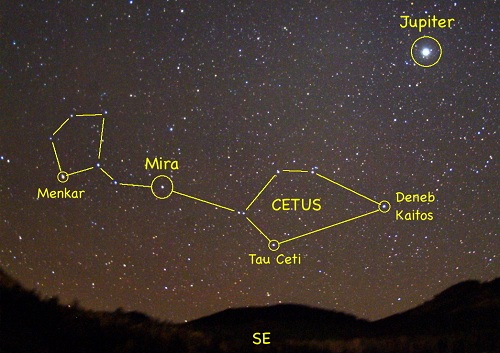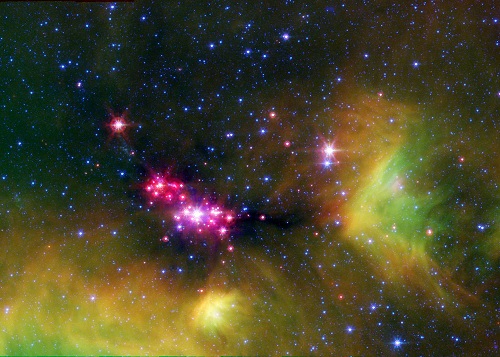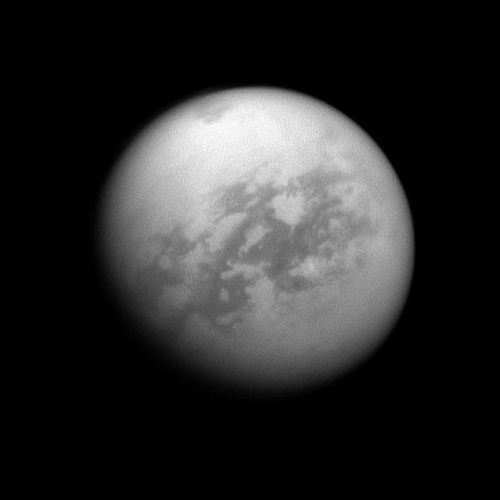Centauri Dreams
Imagining and Planning Interstellar Exploration
Tau Ceti’s Five Planet Candidates
I discovered while trying to get to my copy of Stephen Dole’s Habitable Planets for Man that my office was so choked with stacks of books mixing with Christmas gifts about to be wrapped that I couldn’t reach the necessary shelf. Thus space studies end inevitably in office cleaning, the only benefit of which is that there is now a clear path to the most distant of the bookshelves and Dole’s book (this is the 1964 edition written with Isaac Asimov) now sits before me. I was feeling nostalgic and wanted the Dole volume to remind myself of my early enthusiasm for the nearby star Tau Ceti.
The news that five planet candidates have been identified around this star — one of them in the habitable zone — brings back the fascination that was piqued when Frank Drake made Tau Ceti one of his two targets in 1960’s Project Ozma, a search for extraterrestrial radio signals from Green Bank, WV. And in fact what I found in Dole’s book on the subject of Tau Ceti was mostly about Drake’s interest in this G-class star, along with the even closer Epsilon Eridani. Dole liked Tau Ceti’s similarity to the Sun but in those days we had no evidence of any extrasolar planets.

Image: Photograph of the constellation Cetus, with Tau Ceti identified. Credit: Westlake.
Pushing Data Modeling to the Limit
The latest news, from an international team of astronomers, causes us to look at Tau Ceti in a new and deeper way. Mikko Tuomi (University of Hertfordshire), lead author of the paper on this work, says that the team has found a way to detect radial velocity signals half again as small as any that have been worked with before. Says Tuomi:
“We pioneered new data modeling techniques by adding artificial signals to the data and testing our recovery of the signals with a variety of different approaches. This significantly improved our noise modeling techniques and increased our ability to find low mass planets.”
The big problem in radial velocity studies, according to the paper on this work, is stellar noise, which the researchers refer to as ‘stellar jitter.’ While its magnitude can be uncertain for given stars, the shape of its noise distribution and its variability over time, as well as its dependence on other properties of the star, have not been a major focus of investigation. The team added artificial signals to the radial velocity data of Tau Ceti to see which of its statistical noise models could best extract the artificial noise from the data. Its refined models then allowed the search for low-amplitude signals that had heretofore escaped detection.
As the paper explains further:
To verify the trustworthiness of our noise models in extracting weak signals from the data, we first test their performance by adding artificial signals to the HARPS data set for HD 10700. The models that enable the recovery of the artificial signals are then compared using the Bayesian model selection techniques to find the most accurate descriptions of these HARPS RVs. Finally, we search for periodic signatures of planetary companions in the HARPS velocities.
Just how hard is this paper pushing available radial velocity methods? For a take on that, I turned to planet hunter Greg Laughlin (UC-Santa Cruz), who noted the excitement of what he called ‘this deep dive into the three extremely extensive data sets on a household-name star.’ On the methods involved, Laughlin said this:
…it’s clear that the community is pushing up against the limits of the extant radial velocity data. It will take quite a while to get a substantial confirmation of these planets, since increases in signal-to-noise scale with the square root of the number of measurements, and there are a lot of measurements already.
It’s interesting to see that time-series techniques familiar from econometric analyses (e.g. ARMA(p,q) ) are being applied in this new context. I think that the methods they are using (which would be completely familiar to a Wall Street Quant) have a lot of promise in this particular area.
A Candidate System
Out of this work, conducted with spectroscopic data from HARPS on ESO’s 3.6m telescope at La Silla (Chile), UCLES on the Anglo-Australian Telescope in Siding Spring, Australia and HIRES on the 10m Keck telescope on Mauna Kea, Hawaii, we have five planets with masses between two and six times that of Earth. The candidate in the habitable zone — orbiting its star every 168 days — is about five Earth masses, which the researchers say would make it the smallest planet orbiting in the habitable zone of any Sun-like star. The periodicities of the five in order are 13.9, 35.4, 94, 168, and 640 days, a system telling us that the new noise modeling techniques may have paid off handsomely.
Laughlin’s take on the Tau Ceti candidates is that they are representative of what we have been finding elsewhere:
…the system that they’re proposing is completely _unsurprising_. Kepler and HARPS have demonstrated that the galaxy’s default mode of planet formation is to produce multiple super-Earth/sub-Neptune category planets on nearly circular orbits with orbital periods in the range from days to weeks. This system is certainly a standard-issue example of such a configuration.
Interestingly, the team picked Tau Ceti for the study because they thought it contained no signals. Indeed, Tau Ceti, at just under 12 light years from the Solar System, is a quiet and inactive star for which the HARPS spectrograph had not been able to generate any planetary signatures despite more than 4000 spectral observations. Nor had other searches revealed any signals until this new work. The star is known, however, to have a bright debris disk with a mass estimated to be an order of magnitude greater than the mass of the Kuiper Belt in our own Solar System, extending out to about 55 AU, leading some to assume that any planets there would likely undergo an extensive period of bombardment from objects entering the inner system.
Confirming the Tau Ceti planets will be a story worth watching, for this is a star close enough to the Sun to factor into our thinking for spectroscopic atmospheric analyses in future missions. Quoting the paper again:
With a distance of only 3.7 pc, HD 10700 [Tau Ceti] is the third closest star reported to be a host to a putative planetary system after Epsilon Eridani (Hatzes et al., 2000) with a distance of 3.2 pc and α Centauri B (Dumusque et al., 2012) with a distance of 1.3 pc, though both of these remain to be confirmed and Zechmeister et al. (2005) have cast considerable doubt on the existence of a planet around Epsilon Eridani. This makes HD 10700 an ideal target for future direct-imaging missions. The signals we find, which suggest the presence of low-mass planets, are consistent with both current theoretical models for low-mass planet formation and extant observational evidence for the presence of low-mass planets in the immediate Solar neighbourhood.
The paper is “Signals embedded in the radial velocity noise Periodic variations in the τ Ceti velocities,” accepted for publication in Astronomy & Astrophysics and available online.

Solar System Origins: No Supernova?
How do we get from clouds of gas and dust in interstellar space to stars like the Sun? It takes the right triggering event, which can cause such a cloud to collapse under its own gravity, and we’ve generally assumed that the trigger was a supernova. Indeed, one way to check the theory is to look for the radioactive isotope iron 60 (60Fe), which is considered a marker for a supernova as it can only originate in such an event. Early Solar System materials have shown high levels of iron 60, so a supernova has been assumed to have nudged the Solar System into formation.
But Haolan Tang and Nicolas Dauphas, two researchers from the University of Chicago, have produced results than draw this picture into question. Their samples of meteorites were the same materials other researchers had studied, but the Chicago team used different methods to remove impurities from the observation, producing results with, they believe, fewer errors. What they found was that levels of iron 60 were steady — and low — in the early Solar System material. In other words, there is no clear sign of the explosion of a nearby star just before our Sun was born.
These results seem to be backed up by Tang and Dauphas’ study of iron 58, an isotope likewise produced in supernovae. “The two isotopes act like inseparable twins: Once we knew where iron 58 was, we knew iron 60 couldn’t be very far away,” Dauphas explained. And sure enough, the meteorite samples showed little variation in iron 58, leading to the belief that both isotopes were uniformly distributed. In that case, the iron 60 we do find at low levels must have come from iron 60 that had accumulated in the interstellar medium from supernovae in the distant past.

Image: Scientists in the University of Chicago’s Origins Laboratory have published the latest in a series of papers about the origin of the solar system. Infant stars glow reddish-pink in this infrared image of the Serpens star-forming region, captured by NASA’s Spitzer Space Telescope. Four-and-a half billion years ago, the sun may have looked much like one of the baby stars deeply embedded in the cosmic cloud of gas and dust that collapsed to create it. Credit: NASA/JPL-Caltech/L. Cieza (University of Texas at Austin).
Still problematic is the presence of aluminum 26, which implies that a nearby star was a factor. But did it need to be a supernova? The authors explore the alternatives:
…a nearby stellar source for 26Al is still needed. This could have been a passing AGB-star that delivered 26Al and little 60Fe through stellar winds (Wasserburg et al., 2006). However, the probability of encountering an evolved AGB-star in a starforming region is very low (less than 3 in a million; Kastner and Myers, 1994). A massive star is therefore the favored source for 26Al, requiring special circumstances in order to avoid delivering too much 60Fe.
An AGB (asymptotic giant branch) star is a star of intermediate mass (between 0.6 and 10 solar masses) late in its evolution, appearing to the observer as a red giant. The Chicago researchers make the case that a much larger star, perhaps of 30 solar masses or larger) is implicated, one that spreads aluminum 26 as it sheds its outer layers while keeping iron 60 locked up in its interior:
We favor the first scenario of injection by winds from one or several massive stars… because decoupling of 26Al from 60Fe is a natural outcome of the evolution of massive stars and such pollution is expected to occur in star-forming regions. In the parent molecular cloud to the Sun, massive stars evolved rapidly, blew-off 26Al-rich winds, and carved a bubble within the cloud. The Sun formed later and incorporated some of the bubble shell material polluted with 26Al from the first generation of massive stars.
It’s an intriguing notion, though as I read the paper it can only argue that a nearby supernova is not consistent with the iron 60 levels we see when early Solar System materials are properly analyzed. It takes the giant nearby star scenario to explain the aluminum 26 levels, which otherwise imply a supernova, and on that issue I suspect there will be plenty of debate.
I highlight this paper because of the nature of the investigation. The universe carries its history in the materials around us, which here suggest the passage of a giant star through a cloud of gas and dust that, billions of years later, would become a system populated by beings capable of recovering its origins. And if that doesn’t evoke a sense of awe and perspective, it’s hard to see what would. The paper is Tang and Dauphas, “Abundance, distribution, and origin of 60Fe in the solar protoplanetary disk,” Earth and Planetary Science Letters Vol. 359-360, (2012), pp. 248-263 (preprint).

An Early Nod to Beamed Propulsion
It’s always interesting how different strands of research can come together at unexpected moments. The last couple of posts on Centauri Dreams have involved new work on Titan, and early references in science fiction to Saturn’s big moon. The science fiction treatments show the appeal of a distant object with an atmosphere, with writers speculating on its climate, its terrain, and the bizarre life-forms that might populate it. But early science fiction also proposed ways of reaching the outer Solar System, some of them echoed only decades later by scientists and engineers.

Christopher Phoenix wrote in yesterday commenting on chemist and doughnut-mix master E. E. “Doc” Smith, who when he wasn’t working for a midwestern milling company wrote space operas like The Skylark of Space on the side. Noting that Titan plays a major role in Smith’s story Spacehounds of IPC, Phoenix pointed out that the tale may be the first appearance in science fiction of beamed propulsion. This was just weeks after I had read an upcoming paper by Centauri Dreams regular Adam Crowl on interstellar propulsion concepts in which Crowl singled out E. E. Smith’s prescience, citing this same story.
The beauty of beamed propulsion is that you leave the propellant behind, thus slipping out of the noose of the rocket equation. Solar sails — using only the power of sunlight absent microwave or laser beaming — go back to the earliest days of astronautics — even Kepler had pondered the possibilities when studying comets and the effect of what he thought of as a solar wind upon their tails. Seeing that comet tails always pointed away from the Sun, Kepler homed in on the obvious analogy with seafaring vessels, wondering if fleets of space-borne ships might someday explore the Solar System. Thus his 1610 letter to Galileo:
There will certainly be no lack of human pioneers when we have mastered the art of flight… Let us create vessels and sails adjusted to the heavenly ether, and there will be plenty of people unafraid of the empty wastes. In the meantime, we shall prepare for the brave sky-travelers maps of the celestial bodies. I shall do it for the moon, you Galileo, for Jupiter.”
But sunlight drops off precipitously with distance. As Crowl noted, Smith’s concept in Spacehounds of IPC was to send energy from an installation on a planet, leaving the heavy powerplant off the vehicle by beaming intense coherent electromagnetic waves at the vessel. Here, as Phoenix did in his comment, we can cite Smith himself, who invokes Solar System locales that seemed plausible in the 1930’s, along with something called ‘Roeser’s Rays’ that supply the needed energy to the spaceships:
Power is generated by the great waterfalls of Tellus [Earth] and Venus—water’s mighty scarce on Mars, of course, so most of our plants there use fuel—and is transmitted on light beams, by means of powerful fields of force to the receptors, wherever they may be. The individual transmitting fields and receptors are really simply matched-frequency units, each matching the electrical characteristics of some particular and unique beam of force. This beam is composed of Roeser’s Rays, in their energy aspect…
…this whole thing of beam transmission is pretty crude yet and is bound to change a lot before long. There is so much loss that when we get more than a few hundred million kilometers away from a power-plant we lose reception entirely. But to get going again, the receptors receive the beam and from them the power is sent to the accumulators, where it is stored. These accumulators are an outgrowth of the storage battery…
…From the accumulators, then, the power is fed to the converters, each of which is backed by a projector. The converters simply change the aspect of the rays, from the energy aspect to the material aspect. As soon as this is done, the highly-charged particles—or whatever they are—thus formed are repelled by the terrific stationary force maintained in the projector backing the converter. Each particle departs with a velocity supposed to be that of light, and the recoil upon the projector drives the vessel, or car, or whatever it is attached to. Still with me?”
The reader may or may not be, but these early science fiction magazines were filled with long blocks of exposition as characters explained various scientific principles and fabulations to a rapt audience. Indeed, the letter columns of the science fiction pulps were filled with critiques and analyses of the various scientific ideas on display, some of them highly detailed. For more on this, there is no better source than John Cheng’s essential study Astounding Wonder (University of Pennsylvania Press, 2012).
I’ve always been fascinated by the first appearances of concepts in the early science fiction magazines, but this one had escaped me. A good thing Adam Crowl and Christopher Phoenix were on the case! As Phoenix points out, the energy of “Doc” Smith’s imaginary ‘Roeser’s Rays’ can somehow be used to produce thrust in any direction as opposed to bouncing photons off a departing sail, which would require extreme precision to keep the sail within the collimated beam and navigating to the correct destination. Says Phoenix: “I’ve seen a lot of rocket ships and mysterious “inertial drives” and “warp drives” in early SF, but never a spaceship that rode a beam until Spacehounds of IPC, and this space opera tale could be quite significant for that fact.”
Indeed. In keeping with so much science fiction of the time, Smith’s characters are wooden, his plots lurid, but the appeal of this story is in his imagined technologies. Nor was he above tinkering with a text when asked to adapt magazine work into a novel. Crowl noticed that when you compare the 1947 novelisation of “Spacehounds of IPC” to the earlier 1931 text, Robert Goddard disappears. It was through Goddard’s efforts in liquid fuel propulsion that interplanetary development began in the original, but after Goddard’s death in 1945, the latter disappears from the ensuing novel. Interesting too that Smith always considered Spacehounds of IPC his best work, true science fiction as opposed to what he called the ‘pseudo-science’ that had animated his Skylark novels, where handwaving FTL effects are commonplace.
I notice that P. Schuyler Miller, long a reviewer for Astounding, regarded Spacehounds of IPC to be Smith’s most believable book, a serious upgrade over earlier work. The story was serialized in Amazing Stories beginning in July of 1931 and has had both hardcover and paperback editions in the years since. In fact, the hardcover edition of 1947 was the first book ever published by Fantasy Press, a nice collector’s item. Like Carl Wiley, who under the pseudonym ‘Russell Saunders’ wrote the first article on solar sails for a science fiction magazine (Astounding, in May of 1951), E. E. Smith dished up an SF look at beamed propulsion thirty years before the invention of the laser, a fascinating extrapolation from the technology of his era.

Titan: A Vast, Subsurface Ocean?
Yesterday’s look at a major river on Titan took on a decidedly science fictional cast, but then Titan has always encouraged writers to speculate. Asimov’s “First Law” (1956) tackles a storm on Titan as a way of dealing with the Three Laws of Robotics. Arthur C. Clarke filled Titan with a large human colony in Imperial Earth (1976), and Kim Stanley Robinson used Titanian nitrogen in his books on the terraforming of Mars. As far back as 1935, Stanley G. Weinbaum was writing about a frozen Titan and the struggles of early explorers on that world.
The list could go on, but right now the focus stays on Cassini, which with funding continued through 2017 will continue to give us new and striking discoveries like the river dubbed the moon’s ‘little Nile’ feeding into Ligeia Mare. Nor do I want to ignore the recent work from Howard Zebker (Stanford University) and team, who have been working with Cassini radar data and new gravity measurements to tell us more about the internal structure of Titan and its shape. The idea that Titan boasts a deep subsurface ocean is consistent with the results in this study, which was presented at the annual meeting of the American Geophysical Union earlier this month.

Image: A Cassini view of Titan, with Kraken Mare, a sea of liquid hydrocarbons, visible at the top of the image. The image was taken with the Cassini spacecraft narrow-angle camera on Sept. 14, 2011 using a spectral filter sensitive to wavelengths of near-infrared light centered at 938 nanometers. The view was acquired at a distance of approximately 1.2 million miles (1.9 million kilometers) from Titan and at a Sun-Titan-spacecraft, or phase, angle of 26 degrees. Image scale is 7 miles (12 kilometers) per pixel. Credit: NASA/JPL-Caltech/Space Science Institute.
The model of Titan now accepted is that beneath an icy crust perhaps 100 kilometers thick is an ocean of uncertain depth. Below that is a core that is most likely a combination of ice and rock. The ocean is thought to remain liquid thanks to heat generated by the decay of radioactive elements in the core that go back to the earliest days of the Solar System. Zebker’s team has been analyzing how Titan spins on its axis, and specifically how much it resists any changes in that spin, a factor known as the moment of inertia. He explains the result:
“The moment of inertia depends essentially on the thickness of the layers of material within Titan. The picture of Titan that we get has an icy, rocky core with a radius of a little over 2,000 kilometers, an ocean somewhere in the range of 225 to 300 kilometers thick and an ice layer that is 200 kilometers thick.”
That 200 kilometer ice layer doubles the previous estimate and implies there may be less rock in the core and more ice than had previously been estimated. But the work also has to contend with the fact that Titan’s shape is distorted by the gravitational influence of Saturn, flattening it slightly at the poles. And it turns out that Titan’s shape is more distorted than would be accounted for by the basic gravitational model. Working the numbers, Zebker finds that the density of material under the poles would have to be slightly greater than that under the equator.
Reasoning that liquid water is denser than ice, Zebker’s team comes up with this model: Thinner ice at Titan’s poles — about 3000 meters thinner than the average — and thicker ice at the equator, by about the same margin. The researchers used the combination of gravity and topography to suggest that the average thickness of the icy layer over the ocean is 200 kilometers. The variation in internal heat that would account for the changes in surface thickness may well be the result of tidal influences as Titan orbits the gas giant. Zebker again:
“The variation in the shape of the orbit, along with Titan’s slightly distorted shape, means that there is some flexure within the moon as it orbits Saturn. The planet’s other moons also exert some tidal influence on Titan as they all follow their different orbits, but the primary tidal influence is Saturn. The tides move around a little as Titan orbits and if you move anything, you generate a little bit of heat.”
So the internally generated heat that keeps Titan’s ocean liquid comes not only from radioactive elements but tidal interactions between Titan and Saturn as well as between Titan and the planet’s other moons. Putting these factors into play coupled with analysis of the moon’s moment of inertia allows us to piece together a picture of its internal structure. It’s worth noting that as we continue the study of the outer system, we’re now looking at subsurface ocean possibilities in many places, from Triton to Pluto and conceivably even further out into the Kuiper Belt.
The Titan we’re looking at through Cassini is a long way from the Titan Stanley G. Weinbaum imagined in the story I mentioned at the top, which was “Flight on Titan” (Astounding, January 1935). Weinbaum has a Titan that’s more chilly than frigid, one in which the characters flee native lifeforms as they make a forced march over Titanian mountains, all the while carrying the objects of the journey from Earth, the rare gems called ‘flame orchids.’ Weinbaum’s fantasy Titan bears little resemblance to the hazy, hydrocarbon-saturated surface we see, but it’s a testament to the fact that we have always peopled unknown worlds with the objects of our imagination, a compulsion that, given the means, leads inevitably to journeys of discovery.

Titan’s Big River (and Thoughts of Jules Verne)
One of the wonderful things about daily writing is that I so often wind up in places I wouldn’t have anticipated. Today’s topic includes the discovery of a long river valley on Titan that some are comparing to the Nile, for reasons we’ll examine below. But the thought of rivers on objects near Saturn invariably brought up the memory of a Frank R. Paul illustration, one that ran as the cover of the first issue of Hugo Gernsback’s Amazing Stories in April of 1926. The bizarre image shows sailing ships atop pillars of ice, a party of skaters, and an enormous ringed Saturn.

Is this Titan? The answer is no. The illustration is drawn from the lead story in the magazine, Gernsback’s serialized reprint of Jules Verne’s Off on a Comet, first published in French in 1877 under the title Hector Servadac. A huge comet has grazed the Earth and carried off the main characters, who must learn how to survive the rigors of a long journey through the Solar System, much of the time exploring their frozen new world on skates. I’ll spare you the plot details, but after a perilous fly-by of Jupiter they swing into Saturn’s realm:
…this remarkable ring-system is a remnant of the nebula from which Saturn was himself developed, and which, from some unknown cause, has become solidified. If at any time it should disperse, it would either fall into fragments upon the surface of Saturn, or the fragments, mutually coalescing, would form additional satellites to circle round the planet in its path.
To any observer stationed on the planet, between the extremes of lat. 45 degrees on either side of the equator, these wonderful rings would present various strange phenomena. Sometimes they would appear as an illuminated arch, with the shadow of Saturn passing over it like the hour-hand over a dial; at other times they would be like a semi-aureole of light. Very often, too, for periods of several years, daily eclipses of the sun must occur through the interposition of this triple ring.
If only Verne had been around to see Cassini’s images! Verne’s cometary voyagers can study the heavens with a certain detachment because the comet they are on, called Gallia, turns out to be circling back around toward the Earth, and they believe they will have the prospect of getting home. Off on a Comet is a lively tale. It would be interesting to see what Brian Stableford, who has translated so many early French tales of science fiction into English, would do with the text. Gernsback used a 1911 edition edited and I assume translated by Charles Horne, a New York-based college professor.
On to Titan
Jules Verne had no trouble concocting plots — in addition to his short stories, poems and plays (not to mention numerous essays), he wrote 54 novels in the series called Voyages Extraordinaires between 1863 and 1905. Here among much else are the familiar touchstones From the Earth to the Moon (1865), Journey to the Center of the Earth (1864) and Twenty Thousand Leagues under the Sea (1869). We can only wonder what a Verne armed with Cassini’s latest imagery might have come up with. Take a look, for example, at the river system in the photo below. No skating here, but a boat might work.

It goes without saying that we’ve never seen a river so vast anywhere beyond our own planet, and it does bear a certain resemblance to the Nile, with which it is being compared. What Richard Burton and John Hanning Speke might have given to have had a similar aerial view of the Nile, the search for whose headwaters brought them so much grief and personal animosity. This ‘Nile’ stretches for more than 400 kilometers from its origins to a large sea, its dark surface suggestive of liquid hydrocarbons along the entire length of this high-resolution radar image.
We’re looking at Titan’s north polar region, with a river valley flowing into Ligeia Mare, a sea larger than Lake Superior on Earth. We should actually consider this river a mini-Nile, given that its namesake runs for fully 6700 kilometers, but acknowledging its unique significance (thus far) in our exploration of Titan, the comparison still seems justified. In any case, the river has much to tell us about Titan if we can learn how to read it. Thus Jani Radebaugh, a Cassini radar team associate at Brigham Young University:
“Though there are some short, local meanders, the relative straightness of the river valley suggests it follows the trace of at least one fault, similar to other large rivers running into the southern margin of this same Titan sea. Such faults – fractures in Titan’s bedrock — may not imply plate tectonics, like on Earth, but still lead to the opening of basins and perhaps to the formation of the giant seas themselves.”
Image: Cassini’s view of a vast river system on Saturn’s moon Titan. It is the first time images from space have revealed a river system so vast and in such high resolution anywhere other than Earth. The image was acquired on Sept. 26, 2012, on Cassini’s 87th close flyby of Titan. The river valley crosses Titan’s north polar region and runs into Ligeia Mare, one of the three great seas in the high northern latitudes of Saturn’s moon Titan. It stretches more than 200 miles (400 kilometers). Credit: NASA/JPL-Caltech/ASI.
One day we may have a floating probe on Titan that can trace the course of such a river, working its way out into a dim sea under a sky whose dense cloud would doubtless screen the ringed Saturn from view. What a journey that would be. Even without the garish Frank Paul colors or the wild Vernian imagination, think of human instruments sending back data from a methane sea. Two proposals — Titan Lake In-situ Sampling Propelled Explorer (TALISE) and Titan Mare Explorer (TiME) show us what we might do with near-term technology to make this a reality.

Widening the Habitable Zone
Finding a way to extend the classical habitable zone, where liquid water can exist on the surface of a planet, is a project of obvious astrobiological significance. Now a team of astronomers and geologists from Ohio State University is making the case that their sample of eight stars shows evidence for just such an extension. The stars in question, drawn from a dataset created by the High Accuracy Radial Velocity Planet Searcher spectrometer at the European Southern Observatory in Chile, were selected because they match up well with the Sun in terms of size, age and composition. Seven of the eight, however, show signs of much more thorium than found in our star.
It’s an interesting result, as seen in this Ohio State news release. The slow radioactive decay of elements like thorium, potassium and uranium, all found in the Earth’s mantle, helps to heat the planet. These are elements present at planetary formation and, according to Ohio State’s Wendy Panero, they are involved in producing enough heat to drive plate tectonics, which some believe to be a factor in maintaining our planet’s oceans. All this is in addition to the sources of heat convection found in the Earth’s core, which play a comparable role in crustal movement.
The work was presented last week at the American Geophysical Union meeting in San Francisco by Cayman Unterborn, a graduate student at Ohio State who is working under Panero. Unterborn’s thesis: More thorium in a stellar interior indicates that the interior of planets found around the star would be warmer than the Earth. He notes that one of the stars in the HARPS survey contains 2.5 times more thorium than the Sun. Unterborn’s calculations show that any terrestrial planets forming around that star would generate as much as 25 percent more heat than the Earth, providing a long-lasting driver for plate tectonics. The warmer planet would have a habitable zone farther from its star as well, supported by the additional internal heat.

Image: An artist’s impression of the ‘super-Earth’ HD 85512 b. Is it possible that a planet like this is warmer internally than the Earth, allowing life to form over a wider habitable zone? Credit: ESO/M. Kornmesser.
The cautious Unterborn is aware that he’s looking at a small sample:
“If it turns out that these planets are warmer than we previously thought, then we can effectively increase the size of the habitable zone around these stars by pushing the habitable zone farther from the host star, and consider more of those planets hospitable to microbial life. At this point, all we can say for sure is that there is some natural variation in the amount of radioactive elements inside stars like ours. With only nine samples including the sun, we can’t say much about the full extent of that variation throughout the galaxy. But from what we know about planet formation, we do know that the planets around those stars probably exhibit the same variation, which has implications for the possibility of life.”
The Ohio State researcher notes that thorium is more energetic and has a longer half-life than uranium. Planets rich in the element would tend to remain hot longer than the Earth, which gets most of the heat of its radioactive decay from uranium. As to why we wind up on the short end of the stick when it comes to thorium, Unterborn believes it harks back to the exploding stars that seeded local space with heavy elements long before our planet formed:
“It all starts with supernovae. The elements created in a supernova determine the materials that are available for new stars and planets to form. The solar twins we studied are scattered around the galaxy, so they all formed from different supernovae. It just so happens that they had more thorium available when they formed than we did.”
These results are clearly preliminary, and Jennifer Johnson (Ohio State), a co-author of the study, points to the need to expand its scope. One way to do that is to analyze noise in the HARPS data, something that is now on Unterborn’s to-do list, after which the team plans to expand the search to additional Sun-like stars. If there are indeed large numbers of stars whose basic composition creates planets that generate more internal heat than the Earth, then we need to consider the implications for how we analyze habitable zones and their longevity.


